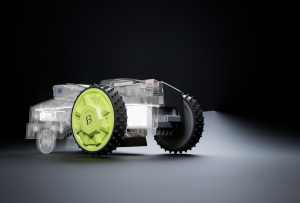
Future Vision and Outlook for Smart Residential Yards in the Next Five Years
Smart yards are on transformation, integrating advancements in computer vision, autonomous driving, robotic arms, AI large models, and IoT networks.
PHILADELPHIA, PA, UNITED STATES, March 29, 2025 /EINPresswire.com/ -- As artificial intelligence, robotics, and the Internet of Things (IoT) continue to advance, smart home technology is rapidly extending to outdoor spaces. Over the next five years, residential yards will be transformed by the integration of vision systems, autonomous driving, robotic arms, large AI models, and sensor networks. From automated lawn care to intelligent irrigation and personalized landscaping management, smart yards will significantly enhance homeowners' quality of life.This article explores the technological breakthroughs driving this transformation, including Visual Simultaneous Localization and Mapping (VSLAM), point cloud reconstruction, LiDAR, Time-of-Flight (ToF) sensors, and other cutting-edge applications.
Visual Perception and Sensing: The Eyes of Smart Yards
Computer vision and sensing technologies will serve as the eyes of the smart yard. VSLAM, combined with point cloud data from LiDAR and ToF sensors, will enable robots to navigate autonomously, detect obstacles, and build accurate 3D maps of their surroundings. These systems can dynamically adjust their paths to avoid people, pets, or unexpected objects, ensuring safe and efficient operations.
A prime example is the TrimBot2020, a robotic gardening system using a 360-degree camera array and VSLAM for autonomous hedge trimming. Similar applications will soon become mainstream, enabling smart yard robots to manage lawns, identify plant health issues, and even track pest activity.
Autonomous Driving and Mobility Platforms
Autonomous mobility platforms will act as the backbone of yard management. Lawn mowers, leaf blowers, and cleaning robots will navigate freely without human intervention. Unlike current models that rely on boundary wires, the next generation will utilize real-time SLAM and GNSS for centimeter-level localization accuracy.
A key example is Husqvarna’s EPOS system, which employs satellite positioning for wire-free autonomous mowing. It’s estimated that the global market for robotic lawn mowers will reach over $4 billion by 2028, driven by increased adoption of autonomous technologies.
Robotic Arms: Precision in Yard Maintenance
Robotic arms equipped with high degrees of freedom and force feedback systems will provide smart yards with enhanced dexterity. With visual guidance and AI-powered decision-making, these arms will perform tasks like pruning, fruit picking, and debris clearing. Mechanical precision, combined with machine learning algorithms, will enable accurate identification of plants' growth stages and early detection of disease symptoms.
Future gardening robots will seamlessly switch between different tasks, using interchangeable tools for hedge trimming, weeding, or soil cultivation. Agricultural models already demonstrate success, with AI-guided robotic arms achieving 90% accuracy in fruit picking.
AI Models and Intelligent Decision-Making
Large AI models will serve as the brain of smart yards. Multimodal AI systems will process data from visual sensors, voice commands, and weather forecasts to autonomously manage yard tasks. Natural language understanding models will allow homeowners to interact with their yard using conversational commands like, “Water the lawn for 15 minutes” or “Trim the bushes tomorrow.”
Additionally, visual AI models will diagnose plant diseases or detect irrigation issues by analyzing imagery data. Companies like PEAT have already implemented plant disease detection systems with 95% accuracy. In the next five years, these models will become even more accurate and accessible.
IoT and Edge Computing: Real-Time Sensing and Response
IoT sensors will monitor a range of environmental factors such as soil moisture, temperature, humidity, and air quality. Data from these sensors will be processed locally using edge computing devices, providing real-time insights and enabling instant decision-making. For example, if a sensor detects dry soil, an AI-powered system will activate the irrigation system immediately, conserving water without requiring manual input.
With 5G and upcoming 6G networks, sensor data transmission will become even faster, ensuring seamless coordination between devices. Edge AI will further reduce latency, enhancing real-time decision-making capabilities.
Integrated System Capabilities and New Experiences
When combined, these technologies will create an intelligent ecosystem for residential yards. Imagine a morning routine where a lawn-mowing robot autonomously trims the grass while a robotic arm tends to the garden. Meanwhile, a perimeter surveillance robot monitors for unusual activity, sending alerts to the homeowner’s mobile device.
Additionally, AI-powered yard management systems will provide predictive maintenance suggestions and suggest optimal watering and fertilization schedules. With augmented reality (AR) integration, homeowners could visualize landscaping design ideas before implementation.
Conclusion
The future of smart residential yards promises a harmonious blend of nature and technology. By integrating computer vision, robotics, AI decision-making, and IoT networks, homeowners will enjoy enhanced convenience, sustainability, and security. The market for these innovations is rapidly expanding, with a projected annual growth rate exceeding 20%.
In the next five years, smart yards will not only automate routine tasks but also provide personalized care for gardens, creating dynamic and enjoyable outdoor experiences. This vision of the future, driven by the convergence of advanced technologies, will redefine how we interact with our living spaces, making them more intelligent, efficient, and connected.
Yulai Weng
LYF Innovation Ltd.
+1 9084140249
email us here
Distribution channels: Politics, Sports, Fitness & Recreation, Technology, Telecommunications, U.S. Politics
Legal Disclaimer:
EIN Presswire provides this news content "as is" without warranty of any kind. We do not accept any responsibility or liability for the accuracy, content, images, videos, licenses, completeness, legality, or reliability of the information contained in this article. If you have any complaints or copyright issues related to this article, kindly contact the author above.
Submit your press release


